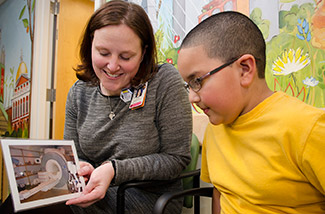Radiation and CT Scans: Making an Informed Decision for Your Child

Radiation doses at Mass General for Children can be half the national average for pediatric patients. Use these frequently asked questions to learn more about radiation and pediatric CT scans.
CT scans are frequently used to diagnose medical conditions or assess trauma in children. They can also be stressful for families. At Mass General for Children (MGfC), we work closely with families to help them make informed decisions about pediatric CT scans.
FAQ for Families
What is a CT scan?
A CT scan (also known as a CAT scan) is a noninvasive medical test that uses special X-ray equipment to produce cross-sectional pictures of the body, like slices in a loaf of bread. It provides a clearer, more detailed image compared to traditional X-rays.
Your child will lie on a table that passes through a tube. The table moves through the tube and X-ray pictures are taken. Time in the scanner is typically very short.
Will my child receive less radiation than an adult during a CT scan?
Yes, children often receive a fraction of the adult dose during a CT scan. At MGfC, our pediatric radiologists have created CT protocols specifically for children. We customize each patient’s CT scan based on size, weight and medical history to get the clearest possible image with the lowest possible amount of radiation.

Are there other tests that do not use radiation?
We use CT scans only when they are medically necessary. Our pediatric radiologists work with our pediatric clinicians to make sure that the appropriate imaging test is ordered to answer the specific clinical question for each patient.
Other tests, such as ultrasound and MRI, do not expose children to radiation but may not always be applicable. Ultrasound can be useful in certain situations but it cannot look deep inside the body and does not provide the anatomic detail of a CT scan. An MRI is very detailed but a much longer exam. It may require anesthesia for children who cannot lie still for a long period of time.
How does MGfC reduce radiation exposure in pediatric CT scans?
Our pediatric radiologists and technologists customize each patient’s CT scan for the lowest dose possible, and our advanced CT scanners produce high-quality images in less scan time.
Our computer systems are designed to safeguard against unnecessary CT scans and prompt radiation-free alternatives based on a patient’s medical history when possible.
How does radiation dose at MGfC compare to other hospitals?
Our radiation doses for pediatric CT scans are consistently among the lowest in the country. Depending on the type of exam, they can be half the national average for pediatric patients.
Resources for Families
Pediatric Health Information Library (PHIL)
Find educational materials on a wide range of pediatric health topics and specialties.

